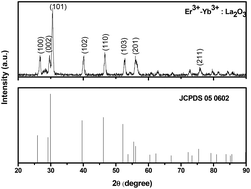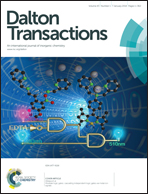Yb3+ sensitized Er3+ doped La2O3 phosphor in temperature sensors and display devices
Abstract
The frequency upconversion emissions in the Er3+/Er3+–Yb3+ doped/codoped hexagonal shaped La2O3 phosphor characterized by X-ray diffraction (XRD) upon excitation with 980 nm and 800 nm CW lasers have been investigated. The upconversion emissions corresponding to the 2H9/2 → 4I15/2, 2H11/2 → 4I15/2, 4S3/2 → 4I15/2 and 4F9/2 → 4I15/2 transitions peaking at 409 nm, 523 nm, 548 nm and 660 nm have been observed under 980 nm excitation whereas 523 nm, 548 nm and 660 nm upconversion emission bands have been visualized under 808 nm excitation. The upconversion emission intensity of Er3+ ions is enhanced by several times due to the codoping with Yb3+ ions, under 980 nm excitation while there is a reduction in intensity in the codoped sample under 808 nm excitation. The decay curve analysis for the green UC emission band corresponding to the 4S3/2 → 4I15/2 transition in the Er3+/Er3+–Yb3+ doped/codoped La2O3 phosphor upon 980 nm excitation has been done. The colour coordinate of the phosphor sample has been calculated at different pump powers and its value is observed to be almost similar to that of the standard green colour and also independent of the excitation power density. The effect of temperature on the upconversion emission intensity of the green emissions has been determined and noted that the present phosphor material can be used in making temperature sensing device upto 600 K.


 Please wait while we load your content...
Please wait while we load your content...